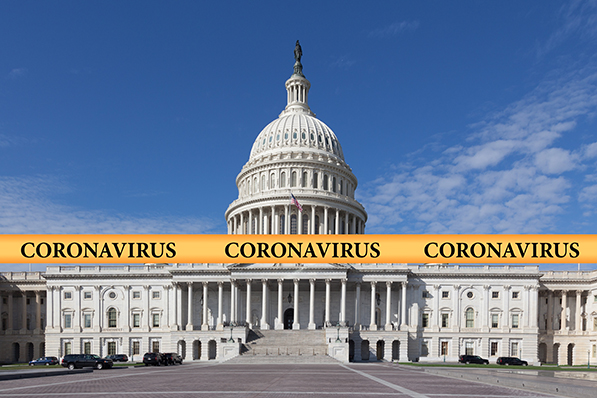
On March 18, 2020, President Trump signed additional emergency relief legislation known as the Families First Coronavirus Response Act (Families First Act). Passed because of the escalating coronavirus (also known as COVID-19) situation, the Families First Act creates expanded employee benefits and protections related to COVID-19, including a new federal paid sick leave law, an emergency expansion of the Family and Medical Leave Act (FMLA) and expanded unemployment insurance provisions.
Updated 3/25: The U.S. Department of Labor says the effective date of the new legislation is April 1 (not April 2).
Emergency Paid Sick Leave
Employers with fewer than 500 employees will be required to provide full-time employees with an additional 80 hours of paid sick leave, or, for part-time employees, the number of hours equal to the hours worked during an average two-week period. For part-time employees with varying schedules, employees can base their calculation on the average number of hours the employee was scheduled per day over a six month period, or, if they haven’t worked that long, the reasonable expectation of the average hours the employee is expected to be scheduled to work.
The leave is available for immediate use by the employee when the law takes effect, regardless of how long the employee was employed, i.e., it does not need to be accrued like most paid leave. The leave is also provided in addition to any existing paid leave previously provided by employers.
Employers must provide this emergency paid sick time when the employee is unable to work (or telework/remote work) because the employee is:
- Subject to a federal, state or local quarantine or isolation order related to COVID-19;
- Advised by a health care provider to self-quarantine due to concerns related to COVID-19;
- Experiencing symptoms of COVID-19 and seeking a medical diagnosis;
- Caring for an individual who is subject to a government quarantine or a self-quarantine advised by a health care provider (reasons 1 and 2 above);
- Caring for their child if the child’s school or place of care has been closed, or the child-care provider is unavailable due to COVID-19 precautions; or
- Experiencing any other “substantially similar condition” specified by the Secretary of Health and Human Services.
Employees must be paid at their regular rate for reasons 1-3 above, except that pay cannot exceed $511 per day and $5,110 in the aggregate. When employees are taking paid sick leave to care for someone else, or the employee is experiencing any other “substantially similar condition,” i.e., reasons 4-6 above, then employers can pay employees two-thirds their regular rate, except that pay cannot exceed $200 per day and $2,000 in the aggregate in those circumstances.
Employees will be required to post the emergency paid sick leave requirements notices for employees. The Secretary of Labor is developing a model notice that employers may use.
The Act also provides quarterly tax credits for employers required to pay sick leave under these conditions. The credits are allowed against the employers’ portion of Social Security taxes. Employers are entitled to credit for qualified sick leave wages, up to $511 per day, or $200 per day if the leave is for caring for a family member or child, for up to 10 days.
The Secretary of Labor has authority to issue regulations to exempt health care providers and emergency responders from these sick pay requirements, including allowing them to opt out. The Secretary may also issue regulations allowing exemption of small businesses with fewer than 50 employees when the sick pay requirements would “jeopardize the viability of the business as a going concern.”
The Emergency Paid Sick Leave program will take effect on April 1 and remain in effect until December 31, 2020.
Emergency Family and Medical Leave Expansion
The Families First Act also temporarily provides emergency FMLA leave for a “qualified need related to public health emergency.”
Coverage and Eligibility: For specified COVID-19-related reasons, the current employee threshold for coverage is changed from covering employers with 50 or more employees to covering any workplace with fewer than 500 employees. Employee eligibility requirements for emergency FMLA are also lowered. Instead of working 1,250 hours in the preceding 12 months, the emergency FMLA provisions apply to any employee who has been employed for at least 30 days.
Reason for leave: The employee may only take emergency FMLA leave when the employee is unable to work (or telework/remote work) due to a need to care for the employee’s child under 18 years of age if the school or place of care has been closed or the child care provider is unavailable due to a public health emergency, meaning an emergency related to COVID-19.
Paid leave: Unlike standard FMLA leave, a significant portion of the emergency FMLA leave must be paid. The first 10 days of emergency FMLA leave may be unpaid. Employees may elect to substitute vacation, personal leave or paid sick leave during that time.
After the first 10 days, the employer must pay full-time employees at a rate of no less than two-thirds of their regular rate of pay for the hours normally scheduled. Employees who work part-time, irregular schedules are entitled to a rate based on the average number of hours worked over a six-month period. If they haven’t worked that long, then they are entitled to the average number of hours per day that the employee would normally be scheduled to work. Paid leave under this law is capped at $200 per day and $10,000 in the aggregate, per individual.
Small Business Exemption: The Secretary of Labor is authorized to issue regulations to exclude certain health care providers and emergency responders and to exempt small businesses with fewer than 50 employees from its requirements when they would jeopardize the viability of the business.
Job Protection: As with standard FMLA leave, the emergency leave is protected, meaning an employer must return the employee to the same or equivalent position upon their return. But, small employers with fewer than 25 employees are exempted if the position does not exist due to economic conditions or other changes in operating conditions that affect employment and are caused by a public health emergency. However, the employer must make reasonable efforts to restore the employee to an equivalent position, and, if those efforts fail, the employer must make reasonable efforts to contact the employee if an equivalent position opens within a year.
Tax Credits: Like paid sick leave, employers will be provided with quarterly tax credits for paid family leave, allowing credits against the employers’ portion of Social Security taxes. Employers are entitled to credit for qualified family leave wages, up to $200 per day for each individual and $10,000 total with respect to all calendar quarters.
The Emergency FMLA program will take effect on April 1 and remain in effect until December 31, 2020.
Unemployment Insurance
The Families First Act also provides $1 billion for emergency grants to states for activities related to processing and paying unemployment insurance benefits under certain conditions. Half of the money will be used to provide immediate additional funding to all states for staffing, technology and other administrative costs. The other half will be reserved for emergency grants to states that experience at least a 10 percent spike in unemployment. Those states will be eligible to receive an additional grant to assist with costs related to the unemployment spike and must take steps to ease eligibility requirements.
This provision will remain in effect until December 31, 2020.
Looking Ahead
The Families First Act is only one of many measures that federal, state and local governments are taking to address COVID-19. Employers can expect swift ongoing developments at all levels of government over the coming weeks and months. Employers should continue to consult regularly with their legal counsel on how to address this new complicated federal framework in addition to the already existing leave laws in the context of their specific circumstances.
James W. Ward, Employment Law Subject Matter Expert/Legal Writer and Editor
CalChamber has you covered! Employers can stay on top of virus- and workforce-related developments by visiting our Coronavirus (COVID-19) resource page, complete with the most relevant government information and CalChamber’s employment-related coverage.






